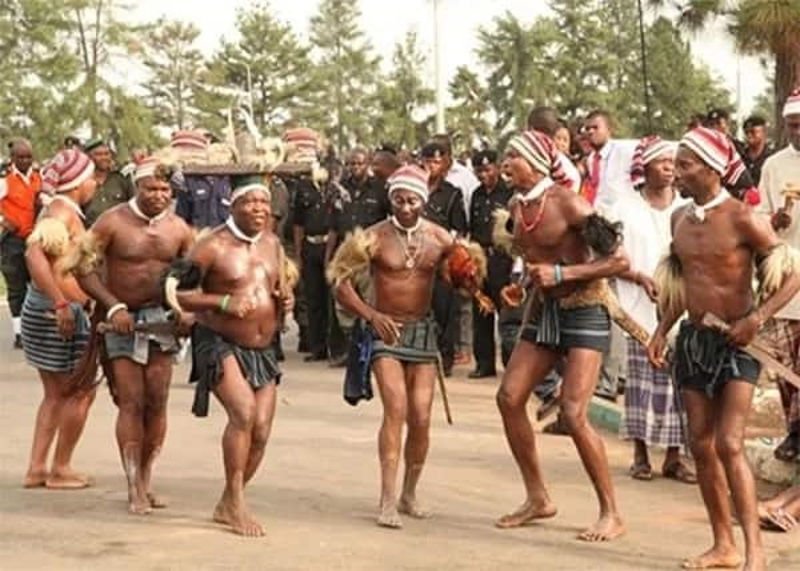The Ohafia are an Igbo speaking people who live in a region of about 100 square miles located west of the Cross River in Southeastern Nigeria.
On these rolling hills twenty-six villages are found, the smallest are comprised of only a few households. The largest is the village of Akanu, the population of which was estimated by Phillip Nsugbe (1974:8) in the mid-sixties to be around 12,000. The ancestral capital of Ohafia is the centrally located village of Elu. The old part of Elu centers on the site where Udumeze, the founder, first built his fire. This is where the shrine of the paramount lineage can be found. The village has now grown to meet its neighbor villages Ebem and Amaekpu. They now comprise a composite area known as Isiama which has a population even greater than Akanu.

Ohafia is part of the Ohafia Local Government Area (LGA) which also includes Abiriba and Nkporo. In the 1940s Ohafia was divided into four local units: Isiama, Ania, Okamu and Ohafor. Within a few years these units were officially constituted as local council areas for regional government purposes. (Nsugbe 1974:35) Since that time, two more local council areas have split off from the original four. The southern section of Isiama is now designated: Ebem-Oha and the village of Okon has become independent of Okamu and is known as Okon-Aku. As a result of the departure of Okon, Okamu was renamed Amaukwu. Ohafia proper is now made up of six local council areas which, along with Abiriba and Nkporo, constitute the eight “autonomous communities” of the Ohafia LGA.
While ritual sanctions have preserved a few patches of virgin forest, nearly all of the arable land in Ohafia is devoted to cultivation. Locally grown yams, cassava, maize, and beans form the core of the Ohafia diet. The traditional system of shifting cultivation requires that land be left fallow for seven years after primary cultivation. Thus, most of the countryside is covered with scrubby new growth providing natural restoration of soil fertility. Wild animals abound in this dense foliage and hunters provide much of the meat eaten in Ohafia. Other protein sources include local fish as well as various sea foods brought from the coast by market women. Some domesticated goats and chickens are raised but these are generally reserved for special occasions.
Ohafia people can be found all over the world and in every imaginable profession. While many have found success in places far from Ohafia, most retain a bond to their ancestral home. Those who reside in Ohafia are as industrious as their brothers and sisters who have moved away. Ohafia women are hardworking farmers and many of those who work as clerks, teachers, civil servants and in other professions also perform some farm work.
This reflects a work ethic that celebrates a fundamental pride in farming. But it also reveals a practical outlook recognizing that farming provides insurance against the instability of the Nigerian economy. Ohafia men are also active in a wide variety of professions but, in general, they devote less time to agricultural labor than women. Land tenure is based on a system of double unilineal descent. Most agricultural land is held by the matrilineal descent groups while residential property and some gardens close to the villages are held by patrilineages.
The Ohafia Warrior Tradition
Prior to the colonial period the ancestors of the Ohafia people were renowned as mighty warriors. This aspect of Ohafia’s history remains fundamental to the Ohafia people’s sense of identity. The warrior’s cap (okpu agu or “leopard cap”) is ubiquitous in Ohafia and is recognized all over Nigeria as a marker of Ohafia citizenship. The Ohafia warrior tradition and its role in the constitution of Ohafia identity is explicitly embodied in the performance of iri agha- the Ohafia War Dance. The warrior identity is deeply ingrained in Ohafia cultural practice and the process of acquiring deep knowledge of the warrior tradition begins in early childhood.
Copyright Warning!
Disclaimer
Just to let you know, comments expressed here do not reflect the opinions of OHAFIATV News or any employee thereof. Also, every opinion expressed in any article is strictly that of the author(s), except where otherwise stated.
ATTENTION: Stay informed and ahead of the curve! Follow OHAFIATV on WhatsApp for updates! CLICK HERE!
Have any thoughts?
Share your reaction or leave a quick response — we’d love to hear what you think!








